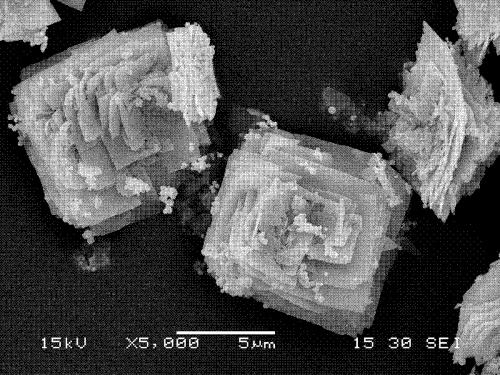Nano-flake Bismuth Tungstate
- Details
- Category: Tungsten Information
- Published on Saturday, 16 February 2019 15:57
In recent years, the problem of environmental pollution has become increasingly serious, and the problem of energy shortage is also imminent. In the face of these two crises, people have launched scientific research on pollution control and environmental protection.

In recent years, more and more researchers have focused on finding biphasic metal oxides with different crystal morphologies, and developing new photocatalysts by expanding the light absorption range to visible light region. Recent studies have found that bismuth tungstate (Bi2WO6) is a layered structure with perovskite-type structure sheets. Bi2WO6 is widely used in related fields because of its dielectric, luminescent, ionized conductor and catalytic properties. Moreover, the most critical is that bismuth tungstate has visible light photocatalytic activity, which can be used to photolysis water and degradation of organic pollutants under visible light.
It is found that according to the different preparation schemes and parameters, bismuth tungstate can be prepared into six kinds of nanocrystalline shapes, which can be used for historical search on China Tungsten Online News Network. This paper mainly introduces nano-flake bismuth tungstate.
Bismuth tungstate nanosheets are square in shape, monolithic layer thickness is 10-100 nanometers, length and width is 1-20 microns. Many Bismuth tungstate nanosheets are stacked in the same direction to form a multi-layer, square ordered stack. The preparation method comprises the following steps:
1.8 g bismuth oxychloride was added to 3.5 ml concentrated nitric acid. After initial stirring, 12 ml deionized water was added. The solution was dissolved and diluted by stirring, and was recorded as solution A. In addition, 1.2 g sodium tungstate monohydrate was added to 60 ml 15% ammonia water, stirred and dissolved, and recorded as solution B.
Solution A droplets are added to solution B, while droplets are stirred to form a uniform suspension. Then the suspension is put into a stainless steel autoclave lined with polytetrafluoroethylene and reacted at 423K for 30 hours. After the reaction, the precipitates were washed with deionized water and then dried in vacuum at 323K to obtain bismuth tungstate nanosheets.
The crystal form of bismuth tungstate (Bi2WO6) is similar to that of standard powder diffraction card (JCPDS: 73-1126). The morphology of Bi2WO6 is approximately square. The thickness of the monolithic layer is about 60 nanometers, and the length and width of the monolithic layer are between 3 and 5 microns. Many bismuth tungstate nanosheets are stacked in the vertical direction of the sheet, forming a multi-layer, square ordered stack.
The bismuth tungstate prepared by the above method is Bi2WO6 type, its crystal form is square nanosheet, the thickness of monolayer is between 10 nanometer and 100 nanometer, and the length and width are between 1 micron and 20 micron. The research shows that nanosheet bismuth tungstate has high potential application value in pollution control, environmental protection, health care, new energy preparation and other fields.
- Tungsten Oxide Manufacturer & Supplier, Chinatungsten Online: www.tungsten-oxide.com
- Tungsten News & Prices of China Tungsten Industry Association: www.ctia.com.cn
- Molybdenum News & Price: news.molybdenum.com.cn
- Tel.: 86 592 5129696; Fax: 86 592 5129797; Email: sales@chinatungsten.com



 sales@chinatungsten.com
sales@chinatungsten.com